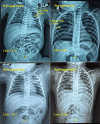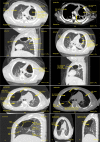Surgical Management of Congenital Pulmonary Airway Malformations (CPAM) in an Infant and a Toddler: Case Report Depicting Two Distinct Surgical Techniques With Successful Outcomes
- PMID: 38314387
- PMCID: PMC10838388
- DOI: 10.7759/cureus.53526
Surgical Management of Congenital Pulmonary Airway Malformations (CPAM) in an Infant and a Toddler: Case Report Depicting Two Distinct Surgical Techniques With Successful Outcomes
Abstract
Congenital pulmonary airway malformations (CPAM) compose the major part of congenital lung malformations (CLM) and have traditionally been treated by pulmonary lobectomy. In terms of surgical strategy, lobectomy has conventionally been the preferred treatment for CPAM localized to a single lobe. More recently, alternative approaches including lung-sparing resections (LSR), such as wedge or non-anatomic resections and segmentectomy, have been suggested. In asymptomatic CPAM early surgical resection is often shown to reduce infection and malignancy development. We describe two patients who were diagnosed with CPAM when being evaluated for respiratory tract infection. Patient 1 (P1) was a two-month-old infant weighing 4 kg with glucose-6-phosphate dehydrogenase (G6PD) deficiency and Patient 2 (P2) was a toddler aged one year, nine months weighing 9 kg. P1 underwent LSR for the CPAM diagnosed in the left upper lobe of the lung with conventional mechanical ventilation whilst right upper lobectomy was performed in P2 using one/single lung ventilation. In both cases, LSR and right upper lobectomy led to an uneventful postoperative recovery with no complications reported.
Keywords: congenital cystic adenomatoid malfomation; congenital cystic lung; congenital pulmonary airway malformation; conservative vs surgical management; infant; lung-sparing resection; segmental resection; surgical management; toddler; wedge resection.
Copyright © 2024, Bhende et al.
Conflict of interest statement
The authors have declared that no competing interests exist.
Figures











References
-
- The natural history of prenatally diagnosed congenital cystic lung lesions: long-term follow-up of 119 cases. Cook J, Chitty LS, De Coppi P, Ashworth M, Wallis C. Arch Dis Child. 2017;102:798–803. - PubMed
-
- Congenital lung lesions. Zobel M, Gologorsky R, Lee H, Vu L. Semin Pediatr Surg. 2019;28:150821. - PubMed
-
- Congenital cystic adenomatoid malformation of the lung. Classification and morphologic spectrum. Stocker JT, Madewell JE, Drake RM. Hum Pathol. 1977;8:155–171. - PubMed
-
- Perinatally diagnosed asymptomatic congenital cystic adenomatoid malformation: to resect or not? Aziz D, Langer JC, Tuuha SE, Ryan G, Ein SH, Kim PC. J Pediatr Surg. 2004;39:329–334. - PubMed
Publication types
LinkOut - more resources
Full Text Sources
Miscellaneous
